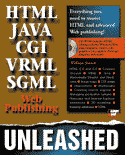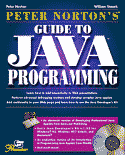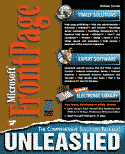


| Peter Norton's Guide to Java Programming |
|---|
| by Peter Norton & William Stanek |
| Table of Contents |
|---|
| Part I Next Stop--Java |
| 1 Introducing Java |
| 2 Getting Started with the JDK |
| Part II Power Primers |
| 3 The Java Browser and the World Wide Web: A Primer |
| 4 The Java Language: A Primer |
| 5 Java Tools and the JDK: A Primer |
| Part III Anatomy of the Java Language |
| 6 Fundamentals of the Java Language |
| 7 Building Objects |
| 8 Tying It All Together: Threads, Exceptions, and More |
| Part IV The Java Application Programming Interface |
| 9 Introducing the Java API |
| 10 The Applet and Language Class Libraries |
| 11 The AWT Class Library |
| 12 The Java I/O and Utility Class Libraries |
| 13 The Net and Debug Class Libraries |
| Part V Developing Java Applets for the Web |
| 14 Creating a Java Applet |
| 15 Creating Java-Powered Web Presentations with Applets |
| 16 Applet Reuse |
| Part VI Developing Stand-alone Applications |
| 17 Creating a Stand-alone Application |
| 18 Using Java Applications in the Real World |
| 19 Application Upgrades |
| Part VII Advanced Issues |
| 20 Designing and Implementing Advanced Applets |
| 21 Designing and Implementing Advanced Applications |
| 22 Integrating Native Programs and Libraries |
| 23 Advanced Debugging and Troubleshooting |
| 24 The Java Virtual Machine |
| Part VIII Appendixes |
| A Java API Table Reference |
| B Java Terminology |
Peter Norton's Guide to Java Programming is the definitive guide to the Java programming language. It is designed to meet the needs of today's Web publishers and programmers by helping you set the pace for the future of Internet and object-oriented programming. Not only does this book provide the broadest and most extensive coverage of essential issues, it is the only book on the market of its kind.
Java represents the future of object-oriented programming, and Peter Norton's Guide to Java Programming is the key to this future. We have taken great care to provide invaluable tips and pour our expertise into every page. As you read this book, you will learn about everything the Java programming language has to offer.
For Internet developers, programmers, and Web publishers, now is the time to get in on the inside track to Java. Throughout much of 1995, Java was in alpha and beta testing. During this time, Java development was limited to the Solaris and Windows NT environments. But all this quickly changed as word about Java spread like wildfire. In January 1996, Sun Microsystems officially released Java 1.0, and you can now obtain free developer's kits for every major operating system including Solaris, AIX, Windows 95/NT, OS/2, and Macintosh.
For nonprogrammers, using a programming language such as Java may seem impossible, but nothing could be further from the truth. The simple fact is that if you can create an HTML, a SGML, or a VRML document, you should be able to create Java-powered documents and applications as well. You will find that Java is easy to learn and use because it eliminates or automates many of the problem areas of earlier programming languages.
The power of Java is that even the most basic Java programs can feature multimedia. Primarily this is because the fundamentals of the Java programming language are easy to learn and use. Through our plain-English approach, we guide you from the fundamentals to advanced programming and beyond. Here are the major topics covered in this book:
The book is designed to be the most comprehensive resource on the Java programming language available anywhere. Chapter by chapter, you will learn everything you need to know to develop and design powerful programs using Java.
Peter Norton's Guide to Java Programming is for today's Web publishers and programmers. Although this book is intended for those with a casual to accomplished knowledge of programming or Web publishing, the plain-English approach makes this book perfect for just about anyone.
Copyright 1996, 1997 William R. Stanek, Sams Publishing, Sams.net Publishing